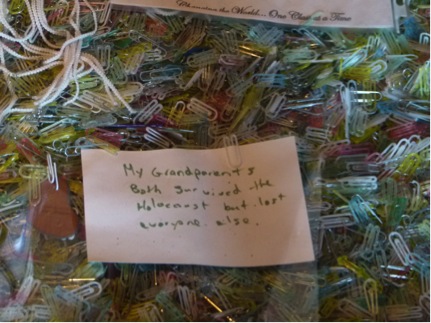(Continued from last time)
Whitwell, Tennessee is a small town (approx. 1600) in the Sequatchie Valley, a short drive from Chattanooga. The Principal of the local middle school, Linda Hopper and David Smith, the Vice Principal at the time (now principal of the elementary school), realized that, when their students graduated, many would go on to universities and/or jobs in different places with a more heterogeneous population. The vast majority of the school’s students and the teachers were white, Anglo-Saxon and Protestant. There were almost no people of color, no foreign or immigrant students, and no Catholics, Muslims or Jews.
David Smith went to a conference in Chattanooga (1998) and on his return suggested a way to try to give students a lesson in diversity by teaching the 8th graders about the Holocaust. The idea was accepted. They decided that the class would be voluntary and the students’ parents were informed and gave their consent. Sandra Roberts, the local language arts teacher was chosen to teach the subject. (Interestingly, she had to learn the subject from the Internet.)
In one of the first classes, Ms. Roberts mentioned that 6 million European Jews, two thirds of European Jews at the time, were slaughtered just because they were Jews. The expectation was that the children would be shocked – they were not. A few of them simply asked, “Ms. Roberts, how much is six million?”
Most of them could write the number but none of them realized what it meant to translate the number to individual people (too big to comprehend – see Wagner’s Op-Ed in the previous post).
Almost immediately, the school realized that the challenge was to try to convert an abstract, collective, concept – such as this very big number – into something that the students would grasp. They decided to collect six-million paper clips to see how big that collection would be. The process of gathering the paper clips is one of the most fascinating aspects of the whole story (“Six Million Paper Clips – The Making of a Children Holocaust memorial” by Peter W. Schroeder and Dagmar Schroeder-Hildebrand, Kar-Ben Publishing, 2004) and (“Paper Clips” a movie written and directed by Joe Fab).
They quickly realized that they didn’t have enough paper-clips locally and that they needed some influx from the outside. They started to publicize (no blogs at that time) the project and the need for paper clips locally, then nationally and eventually globally. They got paper clips with names and stories of Holocaust victims attached and the students were able to associate individual paper clips with individual people that had stories to tell. They counted all the clips. It took some time – but they did pass the six million mark. A German couple, the Schroeder’s, the same couple who eventually wrote the book about the effort, heard the story and decided to try to do something to help. They started to search for an old railcar – just like the railcars that were used to transport the victims to the death camps and concentration camps. They finally were able to locate one and transported it to Withwell, where the full community collaborated to create a small museum that is centered on the railcar that now houses the paper clips.
The clips keep coming to this day.
By the time that we visited the place, a few months ago, the number approached 20 million and the students still count them and get an opportunity to explore the full horrors of the Nazi terror.
When I saw the movie about the project for the first time, it was in a liberators-survivals reunion in Hudson Falls NY at one of the conferences that Matt Rozell (see my first blog) organized. Joe Fab was there to show the movie – and my first thought was, “How can I learn from this experience to be able to individualize the climate change story and refute Wagner’s thesis that individual efforts don’t count?”


I wish to show some thanks to the wiretr just for bailing me out of this scenario. After exploring through the internet and coming across notions which are not powerful, I believed my life was over. Existing minus the solutions to the difficulties you have sorted out all through the article is a critical case, and the ones that could have in a wrong way affected my entire career if I hadn’t encountered your blog post. Your actual know-how and kindness in maneuvering a lot of things was vital. I’m not sure what I would have done if I hadn’t come across such a solution like this. I can also at this point look ahead to my future. Thanks for your time very much for the reliable and effective help. I won’t be reluctant to refer the blog to anyone who needs and wants support on this area.
Whoah this blog is magnificent i truly like reading your articles. Keep up the great paintings! You realize, lots of persons are searching round for this info, you could aid them greatly. 247887
Pingback: Homepage
Pingback: Turning Holocaust “Paper Clips” Into Environmental “Paper Clips” | ClimateChangeFork
30 billion paper clips? one for each ton of CO2 that humans emit into the atmosphere each year.
Of course you would need 5,000 railroad freight cars to display the paper clips.
I just looked that project up – it’s amazing. I’m curious to see how that project connects to your teaching climate change.